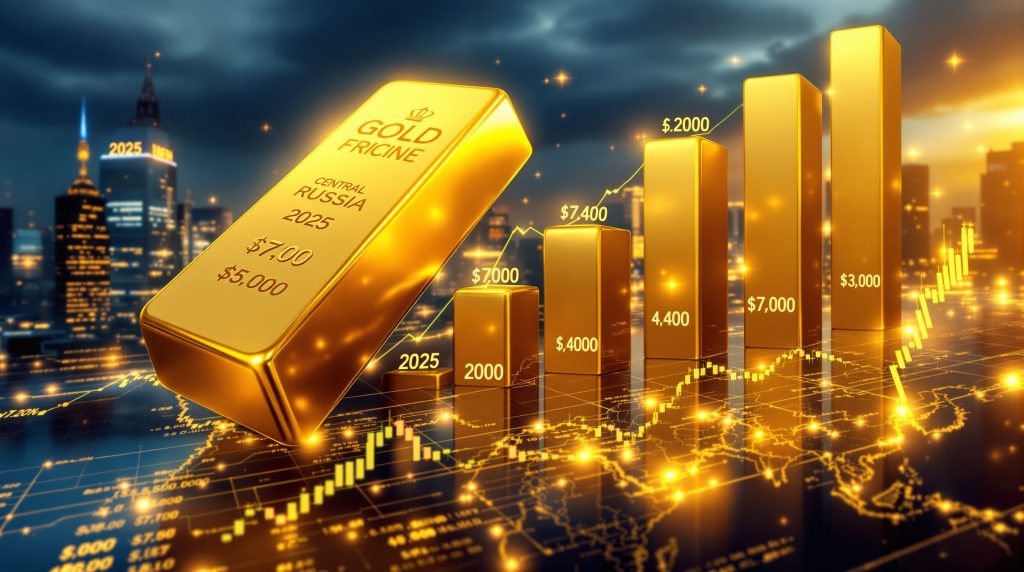How Are Gold Prices Trending in 2025?
The gold market has displayed remarkable momentum throughout 2025, with prices reaching unprecedented levels amid global economic uncertainty. After breaking through the $3,000 per ounce barrier earlier in the year, gold has maintained its upward trajectory, showcasing its enduring appeal as both a safe-haven asset and inflation hedge.
Current price levels represent a significant evolution from previous years, with gold proving itself one of the most resilient investment vehicles during periods of economic instability. Several interconnected factors have fueled this bullish trend, driving demand across various market segments.
Key Price Drivers in the Current Gold Market
The gold market's impressive performance stems from several interrelated factors working in concert:
- Central bank purchasing programs have expanded dramatically, with institutions across Asia, the Middle East, and emerging economies actively diversifying their reserves away from traditional currency holdings
- Geopolitical tensions continue to create market uncertainty, pushing institutional and retail investors toward tangible assets
- Inflationary pressures have persisted despite central bank interventions, enhancing gold's appeal as a wealth preservation tool
- Supply constraints from major mining operations have failed to keep pace with growing demand
- Currency volatility has increased investor appetite for non-correlated assets
These elements have created a perfect storm for gold prices, with market participants increasingly viewing the precious metal as an essential portfolio component rather than merely a tactical allocation.
What Are Leading Analysts Forecasting for Gold Prices?
Financial institutions and market analysts have published increasingly bullish projections for gold through 2025 and beyond. The consensus points to continued strength, though the magnitude and timing of price movements vary across forecasts.
Major Financial Institution Gold Price Forecasts (2025-2026)
| Institution | 2025 Year-End Forecast ($/oz) | 2026 Mid-Year Forecast ($/oz) |
|---|---|---|
| Goldman Sachs | $3,700 | $4,000+ |
| J.P. Morgan | $3,675 | $3,850 |
| Bank of America | $3,500 | $3,800 |
| UBS | $3,500 | $3,700 |
| OCBC Bank | $3,900 | $4,100 |
| Citi Research | $2,700-$3,300 | $3,200-$3,600 |
| HSBC | $2,600-$3,215 | $2,800-$3,400 |
| World Gold Council | $3,000 | $3,250 |
| Société Générale | $3,500 | $3,750 |
These projections reflect a broad consensus that gold will maintain its upward momentum forecast, with most analysts expecting prices to stabilize in the $3,500-$4,000 range by late 2025, with potential for further gains into 2026.
Long-Term Price Projections (2027-2030)
Looking beyond the immediate horizon, several analysts have ventured longer-term forecasts:
- 2027-2028: Median projections cluster around $4,200-$4,800 per ounce
- 2029-2030: Upper-range forecasts suggest potential for $5,000-$7,000 per ounce under certain economic scenarios
These longer-term projections incorporate assumptions about monetary policy evolution, geopolitical developments, and structural changes in global financial systems. According to recent market analysis, veteran resource investor Rick Rule believes gold's structural bull market has substantial room to run.
Why Are Central Banks Driving Gold Demand?
Central bank gold purchases have emerged as one of the most significant factors supporting the gold market in 2025. This trend represents a fundamental shift in reserve management strategies across global financial institutions.
The Central Bank Buying Phenomenon
Since 2010, central banks have transitioned from net sellers to aggressive net buyers of gold, with this trend accelerating dramatically in recent years:
- Historical context: From 1970-2010, central banks were predominantly net sellers of gold
- Inflection point: 2010 marked the transition to net buying
- Current landscape: Central banks now account for approximately 25% of annual gold demand
This shift has been led by emerging market central banks seeking to reduce dollar dependency and diversify reserves. Notable buyers include:
- Russia: Consistent monthly purchasing programs averaging approximately 10 tons
- China: Significant but less transparent accumulation strategy
- India: Steady reserve diversification approach
- Turkey: Aggressive buying despite economic challenges
- Vietnam: Substantial purchasing relative to economic size
These institutions have demonstrated a pattern of "buying the dips," effectively establishing price floors during market corrections and contributing to gold's price stability.
Strategic Motivations Behind Central Bank Purchases
Central banks are pursuing gold for several strategic reasons:
- Dollar dependency reduction: Decreasing exposure to a single reserve currency
- Sanction resistance: Building reserves less vulnerable to international financial restrictions
- Inflation protection: Hedging against currency devaluation
- Portfolio diversification: Improving risk-adjusted returns across total reserves
This behavior represents a structural shift rather than a cyclical phenomenon, suggesting continued support for gold prices over the long term.
How Is Supply and Demand Affecting Gold Prices?
The fundamental supply-demand dynamics in the gold market have tilted decisively toward price support, with production constraints meeting rising demand across multiple sectors.
Production Constraints and Supply Dynamics
Global gold production has plateaued around 4,000 metric tons annually for approximately six years, creating a supply ceiling that amplifies price sensitivity to demand increases:
- Mining output stagnation: New discoveries have failed to offset depleting reserves
- Development timelines: New projects face extended periods from discovery to production
- Environmental regulations: Increasing restrictions on mining activities in many jurisdictions
- Grade deterioration: Declining ore quality at existing operations
- Exploration challenges: Rising costs for finding economically viable deposits
These supply limitations create a structural foundation for sustained price support, particularly as demand continues to expand across multiple market segments.
Demand Expansion Across Market Segments
Gold demand has demonstrated remarkable strength across diverse market segments:
- Investment demand: ETFs, physical bars and coins have seen sustained inflows
- Central bank purchases: As detailed previously, representing approximately 25% of demand
- Jewelry consumption: Resilient despite price increases, particularly in Asian markets
- Industrial applications: Modest but stable demand from technology and manufacturing sectors
This broad-based demand profile provides multiple support mechanisms for gold prices, reducing vulnerability to sector-specific demand fluctuations.
What Makes Gold an Effective Portfolio Hedge?
Gold's performance during various economic scenarios has reinforced its reputation as a versatile portfolio component capable of providing protection across multiple risk environments.
Gold's Performance During Economic Stress
Historical data demonstrates gold's effectiveness during different types of economic disruption:
- Inflationary periods: Gold has historically outperformed during high inflation, as seen during the 1970s and recent inflationary episodes
- Deflationary scenarios: Contrary to common assumptions, gold performed exceptionally well during the Great Depression, with mining stocks like Homestake Mining delivering strong returns while broader markets declined
- Market crashes: Gold has frequently provided portfolio stabilization during equity market corrections
- Currency crises: Gold has preserved purchasing power during currency devaluations and monetary system transitions
This versatility explains why gold is often described as an "everything hedge" rather than merely an inflation hedge. Many investors now consider gold an essential component in their strategic investment insight for navigating economic uncertainty.
Mathematical Progression of Price Increases
An important psychological factor supporting gold's potential for dramatic price increases involves the perception of absolute versus percentage gains:
- A $1,000 increase from $2,000 to $3,000 represents a 50% gain
- A $1,000 increase from $3,000 to $4,000 represents a 33% gain
- A $1,000 increase from $4,000 to $5,000 represents a 25% gain
This mathematical reality means that as the base price rises, equivalent dollar increases become progressively easier to achieve in percentage terms. This dynamic can accelerate price movements during bullish phases as psychological resistance to higher absolute prices diminishes.
How Does Silver Compare to Gold as an Investment?
While gold has captured significant attention, silver has demonstrated compelling performance characteristics that warrant consideration for investors seeking precious metals exposure.
Silver's Price Performance and Relationship to Gold
Silver has historically exhibited several distinctive characteristics relative to gold:
- Higher volatility: Silver typically experiences more dramatic percentage moves in both directions
- Industrial demand component: Approximately 50% of silver demand comes from industrial applications
- Lagging price patterns: Silver often follows gold's directional moves with a time delay
- Greater upside potential: During precious metals bull markets, silver frequently outperforms gold on a percentage basis
In 2025, silver has outperformed gold by approximately 10%, continuing a pattern of catch-up performance following gold's initial breakout.
Practical Considerations for Silver Investment
Beyond price performance, silver offers several practical advantages:
- Affordability: Lower per-ounce price makes physical ownership accessible to more investors
- Divisibility: Practical for smaller transactions during potential monetary disruptions
- Industrial growth potential: Expanding applications in renewable energy, electronics, and medical fields
- Relative scarcity: Above-ground investment-grade silver supplies have diminished due to industrial consumption
These factors have contributed to silver's growing appeal among investors seeking both monetary and industrial exposure within a single asset class.
What Geopolitical Factors Are Influencing Gold Prices?
Geopolitical developments continue to exert significant influence on gold prices, with several ongoing situations creating sustained demand for safe-haven assets.
Major Geopolitical Risk Factors
Several concurrent geopolitical situations are supporting gold prices:
- Regional conflicts: Ongoing military engagements have disrupted supply chains and created economic uncertainty
- Great power competition: Strategic rivalry between major nations has increased economic fragmentation
- Trade tensions: Tariffs and export controls have complicated global commerce
- Resource nationalism: Growing government intervention in natural resource sectors
- Political polarization: Domestic political instability in several major economies
These factors have collectively increased market uncertainty, driving demand for assets perceived as stable during periods of geopolitical stress.
Monetary System Evolution
Beyond immediate geopolitical tensions, structural changes in the international monetary system are supporting gold demand:
- De-dollarization initiatives: Multiple countries pursuing reduced dollar dependency
- Alternative payment systems: Development of parallel financial infrastructure
- BRICS expansion: Growing economic cooperation outside traditional Western frameworks
- Central bank digital currencies: Experimental monetary innovations raising questions about traditional currency stability
These developments suggest a period of monetary system transition that historically has benefited gold prices.
What Technical Indicators Support Higher Gold Prices?
Technical analysis provides additional perspective on gold's potential price trajectory, with several indicators supporting the bullish case.
Chart Patterns and Price Structures
Gold's technical picture displays several constructive elements:
- Multi-year base formation: Consolidation between 2013-2023 created a strong foundation for the current advance
- Decisive breakout: Clear movement above previous all-time highs analysis with strong volume confirmation
- Minimal resistance levels: Limited historical price points above current levels to create psychological barriers
- Positive momentum indicators: MACD, RSI, and other momentum measures showing strong upward bias
- Constructive consolidation patterns: Bull flags and pennants forming during price pauses rather than topping patterns
These technical factors suggest continued upward momentum from a chart perspective, complementing the fundamental case.
Market Sentiment and Positioning
Contrary to typical bull market peaks, current sentiment indicators suggest room for further appreciation:
- Institutional positioning: Many funds remain underweight gold relative to historical allocations
- Retail participation: General public involvement remains modest compared to previous precious metals bull markets
- Media coverage: Mainstream financial media attention to gold remains sporadic rather than euphoric
- Futures market structure: Commitment of traders reports show balanced positioning rather than excessive speculation
These sentiment factors suggest the gold market has not reached the euphoric stage typically associated with major market tops.
How Might Interest Rate Policies Affect Gold?
The relationship between gold and interest rates remains a critical factor for price forecasting, with current monetary policy trends generally supportive of precious metals.
The Gold-Interest Rate Relationship
Gold's performance relative to interest rates involves several nuanced dynamics:
- Real rates vs. nominal rates: Gold correlates more strongly with real (inflation-adjusted) interest rates than nominal rates
- Rate direction vs. absolute levels: The trajectory of interest rates often influences gold more than static rate levels
- Monetary policy expectations: Market anticipation of future rate changes frequently drives gold price movements
- Yield curve dynamics: The relationship between short and long-term rates provides important context for gold performance
Current expectations for interest rate reductions in late 2025 and 2026 generally support the bullish case for gold, as lower rates reduce the opportunity cost of holding non-yielding assets.
Central Bank Credibility Factors
Beyond mechanical interest rate relationships, questions surrounding central bank policy effectiveness are influencing gold demand:
- Inflation control challenges: Persistent inflation despite aggressive rate policies
- Balance sheet concerns: Expanded central bank balance sheets raising questions about monetary stability
- Policy coordination issues: Divergent approaches among major central banks creating market uncertainty
- Political pressure: Increasing political influence on monetary policy decisions
These credibility factors have enhanced gold's appeal as an independent monetary asset outside direct central bank control.
What Investment Approaches Are Available for Gold Exposure?
Investors seeking gold exposure have multiple options with varying characteristics, allowing tailored approaches based on individual objectives and risk tolerance.
Physical Ownership Options
Direct ownership of physical gold offers several advantages and considerations:
- Bullion coins: Government-minted coins like American Eagles, Canadian Maple Leafs, and Australian Kangaroos offering liquidity and recognition
- Gold bars: Available in various sizes from 1 gram to 400 ounces, with larger sizes typically offering lower premiums over spot price
- Allocated storage: Professional vault storage with specific bars assigned to individual investors
- Unallocated storage: Pool accounts where investors own a share of a larger gold holding
Physical ownership eliminates counterparty risk but introduces security, storage, and liquidity considerations.
Financial Instruments for Gold Exposure
For investors preferring market-traded instruments, several options exist:
- Gold ETFs: Exchange-traded funds backed by physical gold
- Gold mining stocks: Equity in companies producing gold, offering operational leverage to gold prices
- Gold royalty companies: Firms holding royalty interests in multiple mining operations
- Gold futures and options: Derivatives offering leverage and strategic positioning opportunities
These instruments provide varying combinations of convenience, leverage, and risk profiles to match specific investment strategies and objectives.
Conclusion: What's the Long-Term Outlook for Gold?
The confluence of factors supporting gold prices suggests a continued bullish environment extending through 2025 and potentially beyond. While short-term corrections remain possible, the structural underpinnings for sustained price strength appear firmly established.
Key factors supporting this outlook include:
- Central bank buying programs showing no signs of abating
- Supply constraints limiting production growth
- Monetary system evolution creating demand for non-sovereign assets
- Geopolitical tensions maintaining safe-haven demand
- Technical momentum supporting continued price appreciation
For investors, gold's dual role as both portfolio insurance and potential growth asset offers compelling value in an environment characterized by elevated uncertainty across multiple dimensions. The latest technical performance analysis confirms that gold's structural bull market remains intact.
The mathematical reality of gold's price progression suggests that as prices move higher, psychological barriers to further appreciation may diminish, potentially accelerating price movements during later stages of the bull market. This dynamic, combined with relatively modest mainstream investor participation to date, indicates potential for significant further upside as broader market awareness increases.
Disclaimer: This analysis contains forward-looking statements based on current market conditions. Gold prices are highly volatile and influenced by numerous factors. Investors should conduct their own research and consider their individual financial situation before making investment decisions.
Are You Searching for the Next Major Gold Discovery?
Stay ahead of the market with Discovery Alert's proprietary Discovery IQ model, which instantly notifies investors of significant ASX mineral discoveries, turning complex gold and mining data into actionable insights. Discover why major mineral discoveries can lead to substantial returns by exploring Discovery Alert's dedicated discoveries page and begin your 30-day free trial today.




